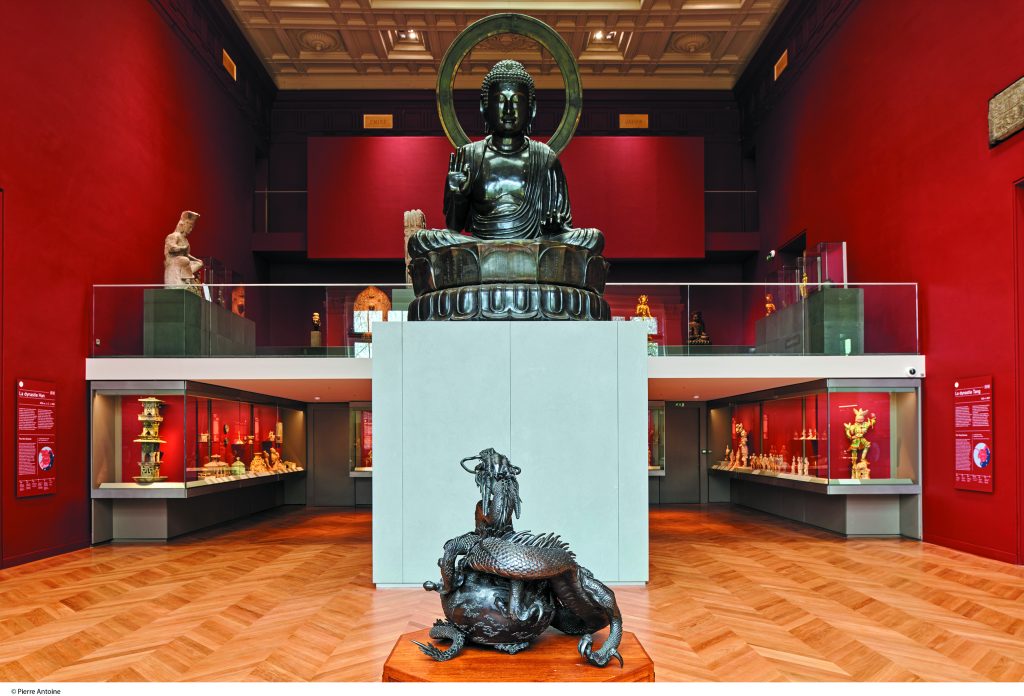Rediscover the City of Light
July 31, 2024
The French capital is often associated with romance, culture, fine dining and, this summer, with sporting prowess as it plays host to the 2024 Olympics. But Paris has long been known as the City of Light (Ville lumière), first in recognition of its role as luminary during the Enlightenment and then as an early adopter of gas streetlights in the early 19th century. While many of its famous landmarks are now centuries old and attract visitors interested in history, some of these monuments and museums represent radical innovations in their own time. The pioneering spirit that informed the city’s nickname is also evident in its cultural institutions, which have often introduced new models that others aspired to emulate.
The Basilique cathédrale Saint-Denis was first built in the 5th century on the tomb of Saint Denis who, following his martyrdom, supposedly walked there carrying his own head. Its choir, completed in 1144, is considered the earliest example of Gothic architecture – pointed arches, flying buttresses and stained glass set the standard for ecclesiastical edifices across Europe. Withstanding wars, looting, a lightning strike and a tornado, the Basilique stands as testament to a revolutionary new architecture style. As a royal necropolis, it also houses 70 effigies and you can read about the medieval embalming methods for French Kings (including salt, spices and plants) in their guide on the Bloomberg Connects app.
Note that app links work best on your smartphone with the Bloomberg Connects app downloaded.

One of the most famous landmarks in Paris, the Arc de Triomphe was similarly influential when inaugurated in 1836. Commissioned by Emperor Napoléon in 1806 to commemorate the contributions and sacrifices of French soldiers, it became a model for triumphal arches elsewhere in the world, as far as Mexico City and Pyongyang. A video in their Bloomberg Connects guide explains how the monument’s location, at the heart of twelve avenues on the bustling Place Charles de Gaulle, developed from a peaceful hill in the countryside into a major tourist attraction. You can also take the Discovery course in their guide, which explores the development, history and iconography of the Arc de Triomphe.

Photography was invented by the Frenchmen Nicéphore Niépce and Louis Daguerre, whose discoveries in the 1820s-30s introduced an entirely new artistic medium. The photographic achievements of subsequent generations are celebrated in the Maison Européenne de la Photographie, the foremost French institution dedicated to photography in all its forms. With an international collection spanning from the 1950s to the present, the MEP highlights the diversity of contemporary lens-based practices. Their robust exhibitions programme, including solo presentations by multimedia French artist Thomas Mailaender and Austrian photographer-painter Tatjana Danneberg, is accessible via their guide on the Bloomberg Connects app.

In the same era as photography was introduced, King Louis XVIII approved the creation of a museum dedicated to living artists in the palais du Luxembourg, today known as GrandPalaisRmn – Musée du Luxembourg. Today a staple of most major cities, contemporary art galleries accessible to members of the public were a novel idea in 1818 and the Musée du Luxembourg became the prototype for a new kind of institution. The museum’s storied history – including wartime looting, a temporary move to the orangery, and a 40-year closure before its reopening in 1979 – is recounted by director Fabienne Charpin-Schaff on their Bloomberg Connects guide. In honor of this year’s Paris Olympics, the museum is hosting an exhibition dedicated to the future of sport and design, which can be visited in person or via the app.
Musée Cernuschi, musée des Arts de l’Asie de la Ville de Paris is one of the oldest and most important Asian art collections in Europe, amassed by its founder Henri Cernuschi (1821-1896) during his travels in Japan and China from 1871–73. The 5,000 works of art he acquired during this trip were augmented by 20th-century archaeological discoveries in China and Vietnam, and more recent additions such as Japanese calligraphy and contemporary Chinese painting. Adapting over the past 140 years to reflect new discoveries or artistic developments, the museum continues to champion Asian art in Europe. You can learn about Japanese tea ceremonies, the Tang dynasty’s musicians on horseback or shamanic relationships between man and beast by viewing the Musée Cernuschi’s collection highlights on the app.

Musée Zadkine immortalizes the life and work of Ossip Zadkine (1888–1967), a groundbreaking Russian-born sculptor who settled in Paris. A master of direct carving, he helped pioneer the introduction of modern art into public spaces, creating The Destroyed City (1951) in response to the devastation of wartime bombing in Rotterdam. A later version of this expressively contorted torso is placed in the museum’s sculpture garden, which you can learn more about in the Essential Works Tour on their Bloomberg Connects guide. In recognition of his artistic contributions, Zadkine was awarded the grand prize of the city of Paris in 1960. The Musée Zadkine is a rare example of a preserved sculptor’s studio in Paris and a reminder of Montparnasse as a thriving avant-garde artists’ quarter.

Continuing the capital city’s pioneering spirit, the above institutions are among 40+ in and around Paris which have recently launched new digital guides on the Bloomberg Connects app. “Digital innovation is essential to make art and culture accessible to all,” explains Christine Macel, Director of the Musée des Arts Décoratifs, Paris. “This collaboration with Bloomberg Philanthropies allows us to present the richness and diversity of our collections in an interactive way.” You can now view these Parisian landmarks and many more via Bloomberg Connects.